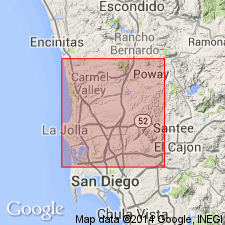
- Usage in publication:
-
- Stadium Conglomerate*
- Modifications:
-
- Named
- Biostratigraphic dating
- Dominant lithology:
-
- Conglomerate
- AAPG geologic province:
-
- Peninsular Ranges province
Summary:
Named as lower formation (of 2) of Poway Group for exposure in vicinity of San Diego Stadium. Crops out from Rancho Bernardo on north to La Mesa and from mouth of Mission Valley on west to within 14 km of Elsinore fault. Type section designated on north wall of Mission Valley about 1 km west of Murphy Canyon Road, beginning at Friars Road and continuing up to rim of valley [La Jolla and La Mesa 7.5' quads] San Diego Co, CA. Is chiefly cobble conglomerate with matrix of dark-yellowish-brown, coarse-grained sandstone, 50 m thick at type section. Conformably overlies Friars Formation (new) of La Jolla Group; conformably underlies Mission Valley Formation (new) of Poway Group. Age is considered middle(?) and late Eocene based on coccoliths identified by David Bukry (written commun., 1969) and other species.
Source: GNU records (USGS DDS-6; Menlo GNULEX).

- Usage in publication:
-
- Stadium Conglomerate*
- Modifications:
-
- Age modified
- AAPG geologic province:
-
- Peninsular Ranges province
Summary:
Age is middle Eocene based on stratigraphic relations [and fossil pollen and spores].
Source: GNU records (USGS DDS-6; Menlo GNULEX).
For more information, please contact Nancy Stamm, Geologic Names Committee Secretary.
Asterisk (*) indicates published by U.S. Geological Survey authors.
"No current usage" (†) implies that a name has been abandoned or has fallen into disuse. Former usage and, if known, replacement name given in parentheses ( ).
Slash (/) indicates name conflicts with nomenclatural guidelines (CSN, 1933; ACSN, 1961, 1970; NACSN, 1983, 2005, 2021). May be explained within brackets ([ ]).

